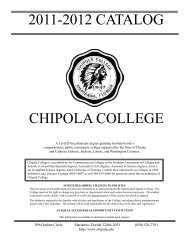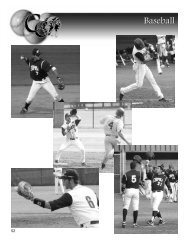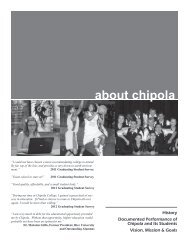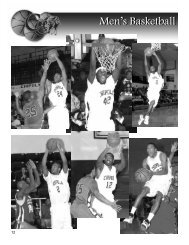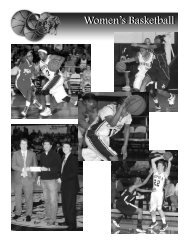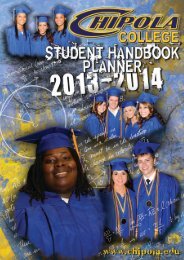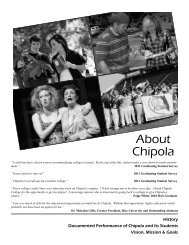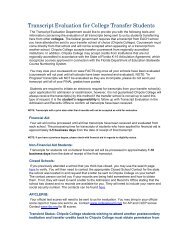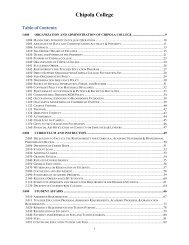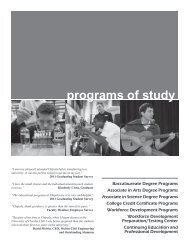MLA (Modern Language Association) Citation Quick Reference Guide
MLA (Modern Language Association) Citation Quick Reference Guide
MLA (Modern Language Association) Citation Quick Reference Guide
You also want an ePaper? Increase the reach of your titles
YUMPU automatically turns print PDFs into web optimized ePapers that Google loves.
<strong>MLA</strong> (<strong>Modern</strong> <strong>Language</strong> <strong>Association</strong>) <strong>Citation</strong> <strong>Quick</strong> <strong>Reference</strong> <strong>Guide</strong><br />
<strong>MLA</strong> in-text citations are made using a combination of signal phrases and parenthetical references. A signal phrase<br />
introduces information borrowed from a source in the form of a quotation, summary, paraphrase, or fact. Usually, the<br />
signal phrase includes the author’s name. The parenthetical reference follows the borrowed material and thereby<br />
signals the end of the citation. It includes at least the page number in parentheses. In sources from the Web where<br />
pagination is not used, it is recommended that a parenthetical note (n.pag.) be inserted; otherwise- without a<br />
parenthetical note- it may not be clear where the borrowed material ended, particularly when the cited material is<br />
paraphrased and there are no closing quotation marks as in the case with direct (word-for-word) quotes.<br />
IN-TEXT CITATION OF DIRECTLY QUOTED SOURCES<br />
Direct quotation of a full sentence: Thomas Beller writes, “Everyone was moving in the same direction, orderly, but<br />
with an element of panic and, beneath that, a nervous energy” (141).<br />
Direct quotation of a partial sentence: Beller notices that “amidst the crowd was a guy who had been on the eighty-first<br />
floor” (141).<br />
Direct quotation of two separate portions of a sentence: Beller remembers that “everyone who was already looking,<br />
turned to see . . . a huge ball of smoke rising” (143).<br />
Direct quotation of something already in quotation marks: The ashen guy says, “’I just got up and started walking’”<br />
(Beller 143). (Note that periods follow parenthetical notes)<br />
Direct quotation that is four lines or longer should be “blocked” using the following format:<br />
Beller gives a vivid description of the ashen guy’s appearance:<br />
At first glance, he looked like a snowman, except instead he was covered in gray, asbestos-<br />
colored ash. He was moving with the crowd, streaming north, up Broadway. His head and neck<br />
and shoulders and about halfway down his chest were covered in gray ash. You could make<br />
bloodshot eyes. . .( 141)<br />
out a pair of<br />
This entire block quotation is not shown , but it is at least four lines when indented 10 spaces on the left margin . Note<br />
that there are no quotation marks. End the blocked quotation with a parenthetical note.<br />
Direct quotation of someone other than the author of the source:<br />
President Obama recently said to Iran’s leaders, “You have refused good faith proposals from the international<br />
community” (qtd. in Cooper 1).<br />
WORKS CITED ENTRY FOR SOURCES QUOTED ABOVE<br />
Beller, Thomas. “The Ashen Guy.” Back to the Lake: A Reader for Writers. Ed. Thomas Cooley. New York:<br />
Norton, 2009. 141-43. Print.<br />
(The word “print” as opposed to “Web” for on-line sources).<br />
Cooper, Helene. “Obama’s Message to Iran Renews Offer for Dialogue.”<br />
New York Times.<br />
21 March 2010: A4L. Academic One File. Web. 16 August 2012.<br />
Note that the signal phrase introducing Beller as the author provides the reader with a direct “link” to the beginning of<br />
the Works Cited page entry which contains all the required information for Beller’s article. Therefore, the article title,
source title, editor’s name, city of publication, etc. is not required in the text of your paper, only the author’s name. If<br />
an author of a source is not identified, introduce the source with the title of the article. Almost without exception, the<br />
signal phrase should contain the same words that appear at the beginning of the works cited entry. (author’s name,<br />
article title, etc.)<br />
Note that President Obama is identified as the person being quoted in the introductory phrase and Helene Cooper’s last<br />
name is inserted in the parenthetical note to identify the author of the article that quoted Obama.<br />
IN-TEXT CITATION OF PARAPHRASED SOURCES<br />
Original source: Times of nurse shortage tend to lead to call for shortened education for nurses. There is ample<br />
evidence, however, that a more educated nurse workforce is associated with better patient outcomes and higher nurse<br />
productivity.<br />
Paraphrase of borrowed material: (NOTE THAT THE ORIGINAL SOURCE MATERIAL HAS BEEN PUT INTO THE<br />
BORROWER’S OWN WORDS AND SENTENCE STRUCTURES).<br />
Linda Aiken points out that when the demand exceeds the supply of available nurses, some support requiring less<br />
education and abbreviating training time. However, sufficient data exists that indicates that nurses with more education<br />
result in more improved patient care and more productive nurses (10).<br />
PREPARING THE WORKS CITED PAGE IN <strong>MLA</strong> STYLE<br />
First, create a separate page for this document. At the top of the page, type Works Cited, centered. Type a list<br />
of the all sources cited in your paper in alphabetical order. Type each entry as its own separate “paragraph”,<br />
double-spaced, using the “hanging indent” format as shown in the examples below.<br />
Second, find a formula and model according to the type of the source you are adding to the WC page.<br />
Type of source: Academic Journal or Article (from a database)<br />
Formula:<br />
Author. “Title of Article.” Journal Title Volume. Issue (Year): Pages. Database title.<br />
Format. Date of Access.<br />
Example:<br />
Matula, Theodore. “Pow! To the People: The Make-up’s Reorganization of Punk Rhetoric.”<br />
Popular Music & Society. 30.1 (2007): 19 -38. Academic Search Complete. Web.<br />
21 Oct. 2009.<br />
For a complete list of source types (magazine or newspaper articles, books, e-books, Web pages, etc.) see the <strong>MLA</strong><br />
<strong>Citation</strong> <strong>Guide</strong> which is easily accessed from the Chipola Library’s Home Web Page.<br />
Also, the OWL at Purdue University is another excellent on-line reference guide.<br />
08/12 Chipola English Department



